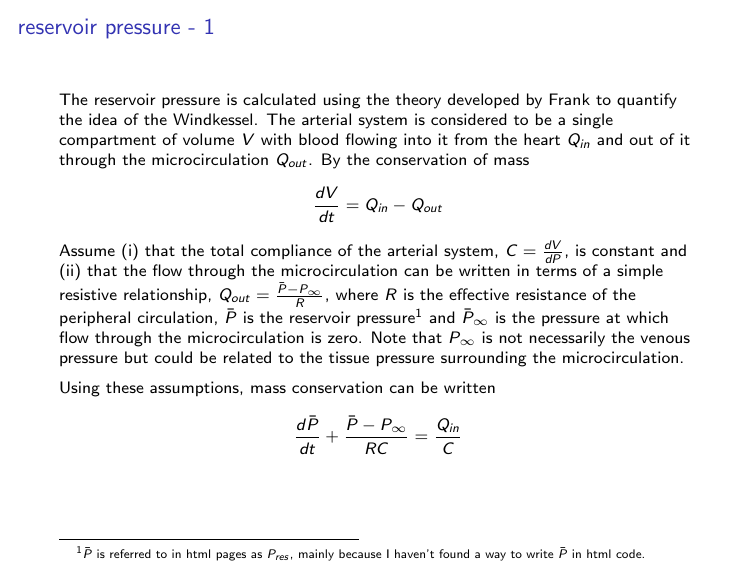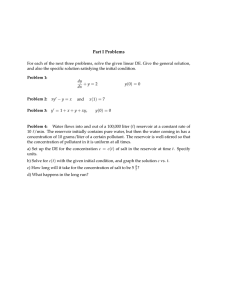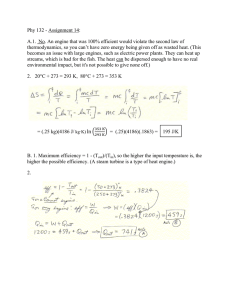mathematical details
advertisement

reservoir pressure - 1 The reservoir pressure is calculated using the theory developed by Frank to quantify the idea of the Windkessel. The arterial system is considered to be a single compartment of volume V with blood flowing into it from the heart Qin and out of it through the microcirculation Qout . By the conservation of mass dV = Qin − Qout dt Assume (i) that the total compliance of the arterial system, C = dV , is constant and dP (ii) that the flow through the microcirculation can be written in terms of a simple ∞ resistive relationship, Qout = P̄−P , where R is the effective resistance of the R peripheral circulation, P̄ is the reservoir pressure1 and P̄∞ is the pressure at which flow through the microcirculation is zero. Note that P∞ is not necessarily the venous pressure but could be related to the tissue pressure surrounding the microcirculation. Using these assumptions, mass conservation can be written d P̄ P̄ − P∞ Qin + = dt RC C 1 P̄ is referred to in html pages as Pres , mainly because I haven’t found a way to write P̄ in html code. reservoir pressure - 2 This equation can be solved by multiplying by the integrating factor e t/τ , where τ = RC , Z t 0 e −t/τ P̄ − P∞ = (P̄0 − P∞ )e −t/τ + Qin (t 0 )e t /τ dt 0 c 0 where P̄0 is the pressure at t = 0. During diastole, when the aortic valve is shut Qin = 0 this solution becomes simply P̄ − P∞ = (P̄0 − P∞ )e −t/τ where we have redefined t = t − Tn where Tn is the time of the start of diastole and P̄0 is the pressure at that time. When Qin (t) is known, these equations can be used to calculate the reservoir pressure. First the exponential fall-off during diastole is fitted to find τ . R is calculated as the ratio of the mean pressure and the cardiac output which, together with τ , gives C . Finally, the reservoir pressure is found by evaluating the integral. estimating the reservoir pressure - 1 Clinically, it is rare to have simultaneous measurements of pressure and flow into the ascending aorta and so it is desirable to find a way to calculate the reservoir pressure from the pressure measurement alone. This can be done if two assumptions are valid: (i) The pressure decay during diastole is uniform throughout the arterial system. (ii) The arteries are well-matched for forward waves. The first assumption says that the τ measured at any point in the arteries is the τ for the reservoir. The second assumption is more subtle, but it implies that the forward wave generated by the flow into the ascending aorta propagates unchanged by local reflections into the arterial system. Since the wave pressure is proportional to the flow in the ascending aorta, this means that the flow will be proportional to the wave pressure at any point in the arteries. This assumption is probably good in the proximal arteries but will become less valid as the measurements are made more and more distally. Mathematically, the second assumption says that Qin = γ(P − P̄) where γ is some constant of proportionality. Using this we can write the mass conservation equation d P̄ = a(P − P̄) − b(P̄ − P∞ ) dt where a = γ/C and b = 1/τ . estimating the reservoir pressure - 2 This equation can be solved explicitly by multiplying by the integration factor e (a+b)t Z t 0 bP∞ P(t 0 )e (a+b)t dt 0 P̄ = P0 e −(a+b)t + (1 − e −(a+b)t ) + ae −(a+b)t a+b 0 As before, b = 1/τ is determined by fitting the pressure measured during diastole to a decaying exponential. This gives a reservoir pressure at the start of diastole P̄(td ) (determined as the time of the dicrotic notch). Finally, a is determined by fitting the integral equation at this time Z td 0 bP∞ P̄(td ) = P0 e −(a+b)td + (1 − e −(a+b)td ) + ae −(a+b)td P(t 0 )e (a+b)t dt 0 a+b 0 Using this value of a, the original integral equation can be solved for P̄ throughout the cardiac cycle. fitting diastolic pressure to an exponential In practice, it is sometimes tricky to fit the pressure during diastole with a decaying exponential of the form P(t) = ae −bt + c where a = P0 and c = P∞ . The main problem is the determination of P∞ which involves an extrapolation to infinite time. The best method we have found involves a modified moments approach. Define the exponentially weighted moments Z En = T (P− < P >)e nt/T dt 0 where t = 0 is taken at the start of diastole td and T is the length of diastole. < P > is the average of P a < P >= (1 − e −bT ) + c bT Evaluating the integral, we get the general expression for En (1 − e −bT )(e n − 1) (1 − e n e −bT ) − En = aT (bT − n) nbT The ratio of any two moments is a function of only b. Therefore, the ratio of the exponentially weighted moment of the measured pressure during diastole can be solved to find b. With this value, any one of the measured moments can be used to determine a. Finally the measured mean can be used to determine c which is the asymptote.





